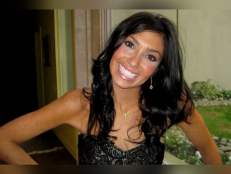5 Things You Need To Know About The Complex Case Of The Jennings 8
Inside the unsolved deaths of 8 women in Louisiana between 2005 and 2009 and who might — or might not — be behind them.
![Detail from FBI poster [FBI]](http://investigationdiscovery.sndimg.com/content/dam/images/investigationdiscovery/crimefeed/legacy/2019/06/2019-06-14-jennings8-FBI-poster.jpg.rend.hgtvcom.616.462.suffix/1560458289382.jpeg)
Detail from FBI poster [FBI]
JENNINGS, LA — Between 2005 and 2009, the bodies of eight local women were found in or around the small town of Jennings in Jefferson Davis Parish, Louisiana.
The victims — who have become known as “The Jennings 8” or “The Jeff Davis 8” — were all different, but they were also deeply connected in various ways. To date, the deaths remain unsolved amid allegations, rumors, and suspicions that have kept both the community and investigators on edge.
Here are five essential facts to know about this convoluted case, as well as the ongoing pursuit of justice for The Jennings 8.
1. Who Were The Women Known As “The Jennings 8”?
The Jennings 8 case focuses on the discovery of eight bodies over the course of four years. Most of the victims knew one another, some quite intimately, and some shared family ties. Here’s a brief timeline of those deaths and their discoveries.
- May 20, 2005: Loretta Chaisson-Lewis, 28
Loretta Chaisson’s nude body was spotted floating in a canal about five miles outside of Jennings. Although examiners said they found significant amounts of cocaine and alcohol in her system, Chaisson’s cause of death remains undetermined.
- June 18, 2005: Ernestine Marie Daniels Patterson, 30
Ernestine Patterson’s remains turned up in a canal about five miles south of where Loretta Lewis was discovered. Patterson reportedly also had drugs in her system, but her throat had been slashed, and wounds on her wrists suggested a significant struggle. Her death is classified as a homicide.
- March 18, 2007: Kristen Gary Lopez, 21
Nearly two years after the first two discoveries, Kristen Lopez’s corpse was also found in a body of water. Lopez was nude, with just one sock on her left foot. Decomposition reportedly prevented an official cause of death from being determined.
- May 12, 2007: Whitnei Dubois, 26
Passersby noticed Whitnei Dubois’s naked body by the side of a public road about five miles outside town. She was the first of the Jennings 8 victims to be discarded on dry land. Although examiners detected a sizable amount of drugs in her system, Dubois’ cause of death has not been determined.
- May 29, 2008: Laconia "Muggy" Brown, 23
Muggy Brown was also found by a roadside. This time, though, investigators classified the death right away as a homicide. Her throat was slit and she'd suffered seven cuts to the neck and three cuts behind her right ear.
- September 11, 2008: Crystal Shay Benoit Zeno, 24
After hunters reported a foul smell in a wooded area, authorities found skeletal remains. Decomposition and natural elements prevented examiners from determining that the remains were those of Crystal Zeno until November 7. To date, no cause of death has been determined.
- November 15, 2008: Brittney Gary, 17
Brittney Gary vanished on November 2. She was last seen alive on video at a dollar store. Then, just a week after the identification of Crystal Zeno’s remains, Gary’s body was found off a highway in Jennings. Authorities identified Gary by her tattoos, but have not been able to determine a cause of death.
- August 19, 2009: Necole Guillory, 26
Just hours after Necole Guillory was reported missing, highway workers allegedly came across her body. No official ruling has yet been made regarding her cause of death.
2. Drug Use Is Reportedly A Fact Of Life In South Jennings, Where All the Victims Lived
According to the Investigation Discovery documentary special Death in the Bayou: The Jennings 8, each of the victims had struggled with drugs. Crystal Zeno’s parents further say that their daughter started using drugs early on and was diagnosed as bipolar when she was 12.
Another common factor among the women is that they all lived on the south side of Jennings. According to observers, South Jennings is the home of the poor and the working class, while the north side is the domain of middle and upper class residents.
The south side is allegedly also known for an illicit trade in drugs and sex.
In Death in the Bayou, Brittany Jones and Taylor Dubois — the niece and sister, respectively, of victim Whitnei Dubois — are shown working at a dry cleaning facility in South Jennings. The two family members have become fierce advocates seeking justice not only for Whitnei, but for all of the Jennings 8.
Pointing toward a window at the facility, Jones says, “To be honest with you, we see a lot of drug deals in the parking lot right here, and we see a lot of soliciting in the [car wash next door]. We get to see our share of criminal activity throughout the day.”
According to Jones, many locals think that the presence of drugs in the victims has only clouded the investigation and distracted from the argument that these women were all murdered.
Drugs further complicate the case among the living, as well, Jones says on the show. As she puts it, “A lot of the witnesses, unfortunately, have a history of drug addiction, and because these are the people who hold the key to all of the information, it’s very hard to have them be reliable witnesses.”
3. Frankie Richard, Who’s Described As A Jennings Underworld Figure, Keeps Coming Up In The Investigation
Time and again throughout Death in the Bayou, both law enforcement and the victims’ loved ones refer back to one man: Frankie Richard.
As KPLC reporter Lee Peck puts it, “Frankie Richard — his name seems to be on everybody’s lips. Everywhere you go, [people say] ‘You need to go talk to Frankie Richard, we think he’s involved.”
Richard appears on the special and is described as a drug user and a drug dealer. He was also allegedly with some of the victims right before they disappeared.
In archival interview footage on the special from KPLC, Richard acknowledges being with the victims, and can be seen stating, “I have gotten high with most of them, okay, most of the girls. Had sex with a couple of them.”
In 2007, while Richard was in jail on an unrelated rape charge, he was reportedly investigated for the murder of Ernestine Patterson and questioned about the death of Kristen Lopez. Both the murder and the rape charges, however, later got dropped.
Richard vehemently denies he had anything to do with any of the deaths and maintains that he has no knowledge about who might have committed these crimes.
Not everyone on the special seems at ease with Richard’s claims, however. Chad and Nick Chaisson, the brothers of victim Loretta Chaisson, say the last time they saw their sister was at a gas station, where she drove off with Frankie Richard.
On the special, Nick says, “I don’t like to judge people, but I just think he’s no good, in my opinion.”
Brittany Jones goes one step further, telling the documentary crew, “Frankie Richard has always been a no-good creep to me. I’ve never heard anything good about him, and I’ve never seen him do anything good.”
Ricky Edwards, the Jefferson Davis Parish Sheriff from 1992 to 2002 says he still wrestles with allegations that Richard was with multiple victims just before they went missing. Edwards states on camera, “He was involved in the last day of their lives, so what does that mean, honestly, I’m not sure.”
4. Local Citizens Reportedly Don’t Trust Law Enforcement, Particularly In Regard To The Jennings 8 Investigation
In December 2008, a task force involving 14 local, state, and national law-enforcement agencies was formed to investigate the Jennings 8 deaths.
It was hoped that the creation of this team would ease the push and pull between families and official investigators, but multiple sources quoted during Death on the Bayou claim that it only made the situation worse.
Some members of the task force allegedly did not do much to alleviate the tension. In 2008, for example, the Louisiana State Police reportedly investigated veteran Jefferson Davis County detective Warren Gary over his purchasing a truck from a possible witness, and fined him $10,000.
Another task force agent, Detective Paula Guillery, reportedly lost evidence and was fired.
5. Many Residents Say They Believe Social Class & Economic Standing Is An Issue That Has Affected The Investigation
Toward the end of Death in the Bayou, numerous South Jennings residents claim that the authorities have not taken the investigations seriously because the victims were poor, had drug issues, and were perceived by the police as maintaining dangerous “party” lifestyles.
The residents also assert that they believe the deaths would already be solved if they had occurred across the border, in more well-to-do North Jennings.
When asked by the documentary team why the cases haven’t been solved, Jennings resident Mary Drake states frankly, “Because the police don’t want them solved. Because — you can go out there and find 9 or 10 people for a murder of one man in Lake Arthur in a couple of weeks’ time, but you can’t find the murderer of eight women over a certain amount of years? What does that tell you? It’s self-explanatory…. To not be concerned about who murdered these women, and to give their families closure, that’s so wrong.”
Watch Investigation Discovery's Death In The Bayou: The Jennings 8 on ID GO now!









